Now that you have a good idea around types of exercises you can incorporate into your routine, we can start thinking about putting them together and linking them to client's goals. Many client's in the gym will come to you for advice on performing resistance training exercises - many of which you have learnt about in the previous topic. To clarify, resistance training aims to improve muscular fitness by exercising a muscle or group of muscles against external resistance. Your clients may wish to engage in resistance training to:
- Improve muscular endurance
- Gain hypertrophy or muscle size
- Improve muscle strength and power.
The topic introduces the concept of resistance training to provide some context for the exercises that you'll learn. We'll cover the specifics of resistance training in more detail in Exercise Prescription Part B, including how to design a resistance training programme.
In this topic, we will cover:
- What is resistance training?
- Resistance training guidelines
- Variation, progression, and maintenance
- Safety considerations.
Resistance training is often also called strength or weight training because it involves performing physical exercises with the aid of weights (body weight or equipment-based weights) to improve muscular strength and endurance. It is associated with using weights like barbells or dumbbells, but resistance bands, body weight (resistance against gravity), and some exercise machines can also be used.
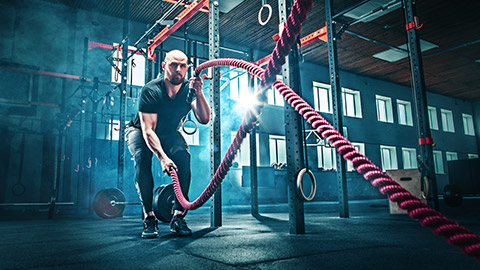
Making your muscles work
Resistance training (weight training) forms a fundamental component of any exercise program. It will also form the bulk of your skillset as a personal trainer in the typical gym environment. Muscle strength is increased by making muscles work against a force or weight.
The main variables of a resistance training programme are:
- Choice (exercise selection)
- Frequency
- Order (exercise arrangement)
- Load (weight)
- Volume: reps and sets
- Rest periods
- Variation
- Progression
When discussing resistance training, we will combine strength and power training together because most of the prescription is matched to strength training.
Clients may need advice about what type of resistance training they should do and general exercise prescription to achieve their goals. With resistance training, there are 3 general goals a client would typically enquire about and seek your advice:
- Improve muscular endurance
- Gain hypertrophy or muscle size
- Improve muscle strength and power
Before we explore muscular endurance, hypertrophy, strength, and power training (and all in between) in greater detail, let's start by looking at some of the benefits of resistance training.
Benefits
The benefits of resistance training include:
- Improved strength and muscle tone
- Improved flexibility and balance
- Improved weight management (either increase or decrease depending on goals)
- Improved muscle-to-fat ratio
- Greater stamina through improved muscular endurance
- Decreased risk of injury
- Improved prevention or control of chronic conditions (e.g., diabetes, heart disease, obesity)
- Improved posture
- Increased bone density
- Improved sporting performance
- Improved self-esteem, self-confidence, and mental health
Equipment
With the variety of resistance techniques, it is no surprise there is an almost equally wide variety of equipment to play with. Which of the following pieces of equipment are you familiar with? Can you competently demonstrate how to use the equipment to a client? Make an honest note of any equipment you are not completely confident in and make an effort to improve these during your self-directed practical learning hours.
Free weights (dumbbells, barbells, and kettlebells)
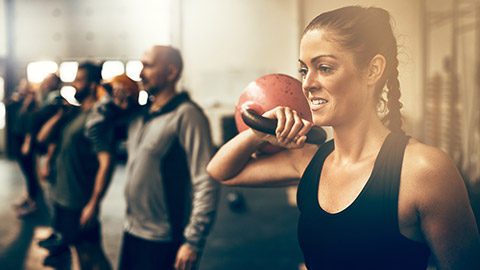
Resistance bands

Weight machines
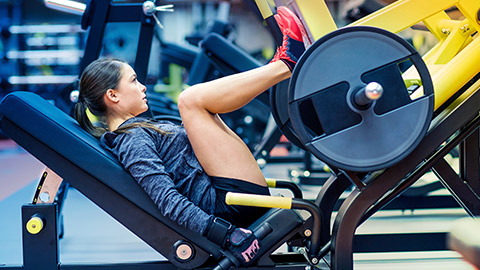
Body weight

Medicine ball or sand bags
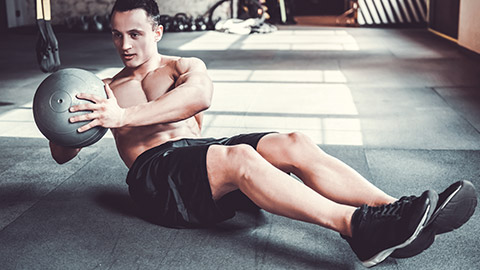
Suspension training
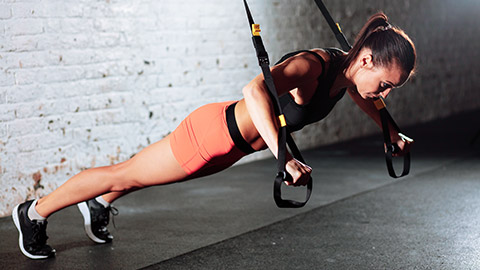
Muscular endurance
Muscular endurance improves local muscle endurance by engaging targetted muscles with a high number of reps with light weights and short recovery periods. I.e., longer periods of light work with short rests. This form of lifting can also improve cardiovascular fitness if enough muscle mass is worked, such as squats vs. biceps curls. It usually forms the starting point for a client's training program.
Focus on your client's technique, work capacity, and general conditioning. Take note of the intensity, repetition range, rest between sets, and purpose of the training for muscular endurance. The following training parameters are a guide:
- Intensity: (%1RM) = less than 65%
- Repetition range = 12-20
- Rest between sets = 30 seconds
- Set = 1-3
- Purpose of training = improve fatigue resistance

Muscular hypertrophy
Hypertrophy, weight training, or muscle mass training is an advanced form of muscular endurance. It still requires a relatively high rep count, but with relatively heavy weights and moderate rest periods. It is a natural progression between muscle endurance and strength training.
The main goal of hypertrophy training is to increase muscle size. This is achieved by altering the volume of training (volume = sets x reps x weight). Volume is the key factor responsible for building muscle mass. The muscle must become fatigued for growth to occur. Take note of the intensity, repetition range, rest between sets, and purpose of the training for muscular hypertrophy.
- Intensity: (%1RM) = 65-85%
- Repetition range = 6-12
- Rest between sets = 60-90 seconds Set = 3-5
- Purpose of training = build lean muscle and tone

Strength and power training
Strength and power training should be done after an appropriate time developing muscular endurance and hypertrophy. Strength training, unlike hypertrophy, is not dependent on training volume, rather on training intensity. You must work at high percentages of your 1RM to maximally stimulate your nervous system. Strength is made up of both neural (nervous system) stimulation and cross-sectional muscle size.
The only way to ‘teach’ the nervous system to recruit as many muscle fibres as possible is to ask the muscles to lift very heavy or very fast (safely!) Strength training does not develop muscle mass in the same way as hypertrophy training, as demonstrated by Olympic weightlifters who are very strong vs bodybuilders who focus on muscle size.
Look at the training factors of intensity, repetition range, rest between sets, and purpose of the training for strength and power.
- Intensity: Strength = greater than 85%; Power = load depends on exercise but movement speed is a key consideration.
- Repetition range = 1-6 (strength) 6-8 (power)
- Rest between sets = 2-5 minutes (strength and power)
- Sets = 3-6
- Purpose of the training: lift heavy and fast (safely).
Summary of resistance training guidelines
The table provides a summary of resistance training guidelines.
| Factor | Muscular endurance | Hypertrophy | Strength | Power |
|---|---|---|---|---|
| Intensity (%1RM) | Less than 65% | 65-85% | Strength: greater than 85% | Power: load depends on exercise but movement speed is the key consideration |
| Repetition range | 12-20 | 6-12 | 1-6 (strength) | 6-8 |
| Rest between sets | 30 seconds | 60-90 seconds | 2-5 minutes | 2-5 minutes |
| Sets | 1-3 | 3-5 | 3-6 | 3-6 |
| Purpose | Improve fatigue resistance | Build lean muscle and tone | Lift heavy and fast | Lift moderately heavy and fast |
You'll learn more about how to design resistance training programmes in Exercise Prescription Part B.
In this subtopic, we'll introduce the concepts of variation, progression, and maintenance. You'll learn more about these concepts and how to apply them to programme design in Exercise Prescription Part B.
Variation
Variation is when a programme includes variations in intensity, duration, and volume. Variation of a training plan can occur within a workout, during the week, or over several weeks. Variation is important:
- to motivate the client and prevent boredom.
- to target specific muscles.
- to challenge your client and see improvements in fitness levels!
- to work on different training goals (i.e. strength, muscular endurance, hypertrophy).
Let us look at variations in common exercises including planks, squats, and push-ups.
Planks
Planks are likely to be in most fitness programmes. Have a look at the image. Are there any variations you can add to this list?
Squats
A squat is a strength exercise in which the client lowers their hips from a standing position and then stands back up. During the descent of a squat, the hip and knee joints flex while the ankle joint dorsiflexes. At the same time the hip and knee joints extend and the ankle joint plantarflexes when standing up.
The following video demonstrates over twenty squat options.
Push-ups
Push-ups are a fast and effective way to build upper body strength and work the triceps, pectoral muscles, and shoulders. They can also strengthen the lower back and core by engaging (pulling in) the abdominal muscles. Push-ups are one exercise in which there is lots of variety so your client should never get bored!
Watch the video below for over thirty variations. Have you seen any other variations in your gym (or elsewhere)? What exercises would challenge you or a client?
Progression and maintenance
An essential component of any training program is progression and maintenance. What is the difference? What do you do when you have accomplished something? Take on the next level!
We do not like to be bored, neither do we stick with the same exercise program. Once our bodies have accomplished a skill, we either need to keep doing it to keep us 'fresh' or step it up and learn new aspects of the skill. The same is required from an effective training programme (and to keep clients).
- Progression: The process in which the client continues to move towards a predetermined goal.
- Maintenance: When the goal has been achieved and the client is attempting to maintain a specific level of fitness.
Progression and maintenance can be achieved through increasing loads, volume, or frequency, or making alternations that modify the training stimulus. Different training loads have different effects on the client’s recovery.
Study the graph below and see what this means in terms of whether the training is too easy, adequate, or too hard. Note where overcompensation is also occurring. You will see there is an optimal threshold from maximal supercompensation following a training program. Keep this graph in mind when designing a programme for clients in the progression or maintenance stage and vary the factors you are learning about to create an effective and relevant programme.
Remember, supercompensation or overcompensation is just a fancy word for increased fitness adaptation. Anything that enhances supercompensation will improve long-term training progression.
Ensuring your personal safety and the safety of your colleagues, clients, and any other visitors to the gym (or any location where you are working) is non-negotiable. A zero-tolerance for unsafe practices will ensure the risk of injury is controlled. Industry bodies ensure a code of ethics and practice is adhered to.

Injury
Common causes of injury include:
- Incorrect technique and poor training
- Too much weight
- Bad spotting
- Incorrect use of cheating and forced reps
- Training too often
- Not stretching and inadequate warm-up
- Lack of concentration
- Too much 'bro science'
- Excessive pre-workout
Let's look at the consequences of each.
Too much weight
As a rule of thumb, never increase lower body exercises by more than 10% and upper body exercises by more than 5%.
Too much weight and muscles can start to break down making them prone to injury. The first warning signs are symptoms similar to the classic overtraining syndrome that endurance athletes experience including soreness and fatigue. As soon as a client starts to lift too much weight you will quickly see their technique fall apart.
As a trainer, always prioritise technique and form over load. This is where a good trainer comes into their own with great cues to help people perfect their form and lift appropriate amounts of weight.
For beginners, always start with lighter weights and aim for more reps over the initial weeks. Once their form becomes engrained and they have developed a base of muscular endurance they can slowly increase weight.
Bad spotting
Spotting means supporting another person during an exercise, allowing the client to lift or push more than they could normally do but push more safely. A spotter's primary role is to assist an exercise to help protect the client from injury. A spotter may also provide additional motivation to the client to help the client develop confidence and improve their techniques and achieve the additional weight or additional repetitions. This is usually only done with free weight exercises:
- Bench press
- Barbell back squat
- Military press
- Skull crusher
- Upright row
- Dumbbell bench press
- Dumbbell flies
- Dumbbell shoulder
The following image shows a personal trainer spotting a client with his hands ready to assist if required. Note the position of the spotter behind the bench which allows an appropriate distance from the client.

Your gym may have specific requirements for spotting. E.g., exercises you should not spot because they can be dangerous to the client and you as the personal trainer. You will need to check this with the gym's manager. These may include:
- Deadlifts
- Crunches
- Hyperextensions
- High pulls
- Push press
Incorrect use of cheating and forced reps
In simple terms, cheat reps are overloading the muscles you intend to train and getting other muscles involved to lift more weights. In other words, any exercise in which momentum or additional muscles are used to complete the exercise. E.g., whipping legs back and forth when performing a chin-up (dolphin kicking) or swinging the hips and using the legs to assist in dumbbell curls.
Cheat reps enable the client to utilise additional volume and push the muscles past the point of failure. Cheat reps are cheating, and can result in injury.
Cheat reps can be incorporated into programmes that, if done with an understanding of the science and rationale behind them, can be safely incorporated. A solid rule of thumb would be 90-95% of each set should be performed to perfection before considering a cheat rep for the last rep as a finishing touch to the set. The need for cheat reps for your client's programme will be best determined by their goals and is generally thought of as more of a strength and power style of training.
Forced reps require a spotter and are done after the client has run out of steam towards the end of a set. At that point, the spotter will lift an increasing percentage of each remaining rep which allows the client to complete the set. If you have ever experienced fatigue at the end of a set, you will know that a cheerleader at this stage is a hugely appreciated support. A spotter is also a motivator for the client (or exercise partner) to help get them across the line and complete their set.
The biggest mistake is when the client does not make the spotter aware of what is happening. Forced reps also put the muscle in a very fatigued position which increases injury risk substantially. Communication is key. Encourage your client to talk to you during their sets and let you know their intentions and capabilities.
Training too often
Training at too high of intensity or duration too often can result in overtraining, which can trigger adverse side effects that indicate your client is working too hard. While this may not happen immediately, if the client is training too often with insufficient rest the body will suffer fatigue.
Technique will also be adversely affected, gains will be limited, and ultimately the body may shut down. This results in a greater time off training than a rest day or two would have taken. The human body does not adequately adapt to training in a state of constant fatigue. One of the most important skills for a trainer to master is training volumes and recovery periods.
Not stretching
When the muscles are activated, they contract and produce movement for a variety of purposes from escaping from dangerous situations to general exercise and movement. When resistance is added (either resistance offered by gravity or by adding additional weights) this increases the tension created during each muscular contraction and often sees a shortening of the muscles.
Not stretching results in muscle tightness and a decrease in performance. It can also:
- Increase the risk of injury
- Cause muscle degeneration and poor circulation such as tingling, numbness as well as pain and muscle cramps
When stretching, the aim is to remove the tension in the ligaments and tendons around the joints and in the muscles and send oxygen and other vital nutrients in the blood to the muscles. Advise your client to stretch to the point of tension but not to the point of pain, hold stretches for 15-30 seconds, and use various stretching techniques when the muscle is warm.
A key pointer when stretching: breathe! It sounds obvious but many people forget to breathe and hold their breath during a stretch.
Inadequate warm-up
Warm-ups increase heart rate and blood flow to the muscles which help prepare the body for exercise. If clients do not warm-up, they may experience muscle cramps, injury, decreased performance, and can fatigue prematurely.
Lack of concentration
Lack of concentration may lead to serious accidents or events. Paying attention to how a client is performing an exercise, their level of exertion, and their physical responses to the exercises (e.g., gasping for air or being shaky) is an important duty of care personal trainers have to their clients. As a trainer, it is important that all your attention and focus is on your client. Any text messages or socialising with others can wait until the client, who is paying for your services, has finished their session.

Excessive pre-workout
Pre-workout supplements before exercising are becoming increasingly popular before exercise. If it is being incorporated into a training regimen, it is recommended around 20-30 minutes before the workout. For clients who prefer to work out in the evenings, be careful how late the client consumes the pre-workout. If the client is planning on taking it a few hours before getting some shuteye, then suggest the client reconsiders.
Pre-workout supplements may provide an energy boost but, they can cause side effects including vomiting, jitters, cramps, high blood pressure, and in rare cases, cardiac arrest.
